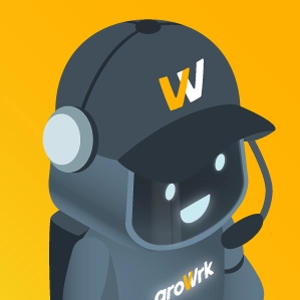Learning and development practices for remote workers
 Mara Quintanilla
Mara Quintanilla
Implementing learning and development (L&D) practices is one of the best ways to ensure your remote team is engaged while boosting company productivity.
Companies often invest a lot of energy and resources to select the right talent and provide a welcoming culture, but the remote employee lifecycle continues beyond there.
The best companies go the extra mile to create a great remote culture where employees can develop their knowledge and gain new skills that will ultimately allow them to grow.
According to LinkedIn's 2023 Workplace Learning Report, 89% of L&D professionals agree that building employee skills will help companies navigate the evolving future of work.
When employees feel that their skills are growing, their engagement and productivity increase, and when teams are engaged, companies see a positive impact on business outcomes.
Let's examine how organizations can implement effective learning and development programs for remote employees.
Learning and development expectations and goals as a remote worker
The first step to implementing effective L&D practices for remote workers is clearly defining the expectations and goals for remote learning and development. This includes explaining what skills and knowledge the company expects the employees to acquire relevant to their career development within the organization.
Often, companies will provide a learning budget that employees can use as they see fit. Without guidance or expectations, employees may be prone to using this budget towards personal interests that aren’t precisely aligned with their role’s duties.
In these cases, firms must be clear on how workers must use stipends and the type of skills that they need to learn. Manager approval can also be easy for companies to determine if employees follow a relevant learning path.
Defining expectations and goals can also look like setting up meetings or surveys. This way, remote employees get to discuss their learning and development needs and goals.
For example, suppose a designer in the Product team wishes to learn how to code. In that case, conversations with a manager can help identify the courses and internal projects they could work on to follow this career path.
Tailoring employees’ learning and development needs ensures that they stay motivated and engaged while also targeting the company’s needs.
Online learning methods
Once the expectations and goals for remote L&D have been defined, companies can explore the various online learning methods available for remote workers.
According to Fordham University, online learning can be divided into synchronous and asynchronous courses.
Asynchronous online learning
This type of learning does not happen in real-time. Employees can follow content and assignments at their own pace and don’t usually have to engage with teammates.
All interaction happens through written communication tools or pre-recorded video content. Common async learning formats include e-books, tutorials, and articles.
Synchronous online learning
On the other hand, synchronous learning requires an instructor and teammates to interact online simultaneously. Participants can use text, video, or audio chat in a live environment.
Although participants need to be present in real-time, online learning allows them to be anywhere as long as they have a strong internet connection. Webinars and virtual instructor-led training are typical examples of synchronous learning.
Peer to peer learning and knowledge sharing
Peer-to-peer learning and knowledge sharing are effective ways to build skills in remote teams without the overhead of travel costs or instructor time.
For example, if you need a team member to learn a new software program, you might provide them with live training from an expert online. If you want everyone on your team to understand the new marketing plan, you could record a meeting where your team members can interact with each other throughout the day.
Encouraging peer-to-peer learning and knowledge sharing can be a powerful way to foster continuous learning in remote teams. By creating a culture of knowledge sharing, companies can ensure that their remote employees are continuously learning from each other and that knowledge and expertise are not siloed within individual employees.
To encourage knowledge sharing, companies can provide remote employees access to virtual collaboration tools like Slack, Google Meet, Zoom, and Microsoft Teams. These tools allow remote employees to easily communicate with each other and share knowledge and experience, regardless of their location or time zone.
Progress reviews and check-ins
Regular check-ins and progress reviews ensure remote teams are on track with their learning and development goals. These can be done through one-on-one meetings with managers, regular team meetings, and check-ins.
During these check-ins, managers can assess the progress of their remote employees' learning and development and provide them with feedback and guidance on how to continue growing in their roles. This can help remote employees stay motivated and engaged and ensure that they continuously improve in their roles.
Coaching and mentoring
Offering virtual coaching and mentoring opportunities is also an effective way to foster continuous learning and development in remote teams. Organizations can do this through virtual coaching and mentoring sessions, where remote employees are paired with experienced professionals who can guide and mentor them.
Virtual coaching and mentoring can provide remote employees with valuable insights and guidance on how to succeed in their roles and help them identify areas for growth. This can also enable remote employees to build relationships with their colleagues and feel more connected to their team, despite being physically distant.
Continuous adaptation
As the remote work environment continues to evolve, it's essential for companies to regularly assess and adapt their L&D programs to meet the changing needs of their remote employees. Getting employee opinions through feedback surveys and check-ins is an easy way for organizations to assess these programs' effectiveness and determine improvement areas.
By continuously adapting their L&D programs to meet the changing needs of their teams, companies can ensure that their remote employees remain engaged and motivated in their roles.
Recognition and rewards
Implementing a system for recognition and rewards can also effectively motivate and engage remote employees in their learning and development. This can include rewards like gift cards, bonuses, or other incentives for completing L&D programs or achieving specific learning and development goals.
By recognizing and rewarding remote employees for their efforts, companies can show appreciation for their remote employees' hard work and dedication and encourage them to continue growing and learning in their roles.
Wrapping up
As remote work becomes the future of work, organizations must intentionally provide learning and development resources to ensure employees remain competitive in their industries.
Learning and development programs can help remote workers feel connected to their organizations and motivated to grow professionally, resulting in higher retention rates, reduced turnover costs, and happier employees that provide high-quality work.
Support your remote teams with the right tools so they can take full advantage of learning and development opportunities. GroWrk can help you deliver the equipment that remote teams need at the location where they need it. No hassle. Book a demo call today to get started.
FAQs
What are the benefits of online learning for remote workers?
Online learning provides flexibility and convenience for remote workers. It allows employees to learn at their own pace and in their own time. It also provides access to a wide range of courses and resources.
How can remote workers stay motivated to learn and develop new skills?
Remote workers can stay motivated by setting personal learning goals, connecting with other remote workers, and participating in virtual communities of practice. Recognition and rewards programs can also motivate remote workers.
What is the best way to evaluate the effectiveness of a remote learning and development program?
The best way to evaluate the effectiveness of a remote learning and development program is to assess its impact on employees and the organization regularly. Companies can do this through surveys, feedback sessions, and other evaluation methods.






